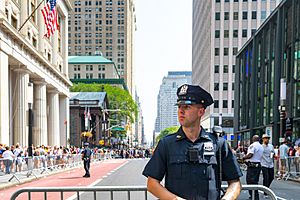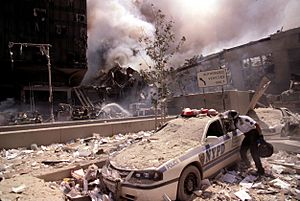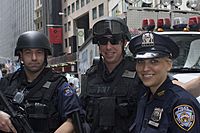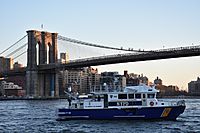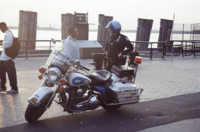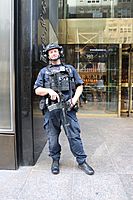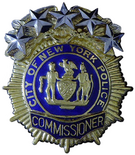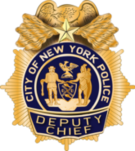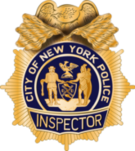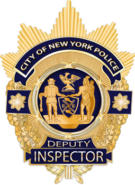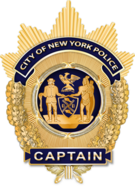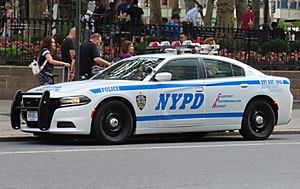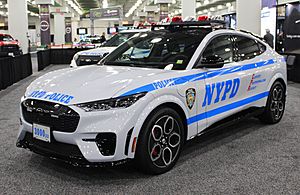New York City Police Department facts for kids
Quick facts for kids City of New York Police Department |
|
|---|---|
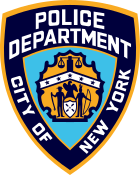
Patch
|
|

NYPD shield (officer)
|
|

|
|
| Common name | New York City Police Department |
| Abbreviation | NYPD |
| Motto |
|
| Agency overview | |
| Formed | May 23, 1845 |
| Employees | 50,676 |
| Annual budget | US$5.4 b (2022) |
| Jurisdictional structure | |
| Operations jurisdiction | New York City, New York, United States |
 |
|
| Size | 468.484 sq mi (1,213.37 km2) |
| Population | 8,468,190 (2021) |
| Legal jurisdiction | As per operations jurisdiction |
| General nature | |
| Operational structure | |
| Headquarters | One Police Plaza, Lower Manhattan |
| Sworn Officers | Approximately 36,000 Sworn Officers |
| Civilian Employees | Approximately 19,000 Civilian Employees |
| Police Commissioner responsible |
|
| Agency executives |
|
| Units |
List of units
Auxiliary police
Emergency service Highway patrol Housing bureau Major case squad School safety Transportation bureau Detectives Bureau Information Technology Bureau |
| Facilities | |
| Commands |
|
| Police vehicles | 9,624 |
| Police boats | 29 |
| Helicopters | 8 |
| Horses | 45 |
| K-9 units | 34 |
The New York City Police Department (NYPD) is the main law enforcement agency in New York City. It was started on May 23, 1845. The NYPD is the largest and one of the oldest city police departments in the United States.
The NYPD's main office is at 1 Police Plaza in Lower Manhattan, close to City Hall. The NYPD has special units like the Emergency Service Unit, K-9 (police dogs), harbor patrol, highway patrol, and air support. They also have teams for bomb threats, counterterrorism, and organized crime.
The NYPD has over 40,000 people working for it. More than 30,000 of these are uniformed officers. In 2019, the NYPD handled almost 500,000 crime reports and made over 200,000 arrests. Because it's in New York City, the NYPD is often shown in movies, TV shows, and video games.
Contents
History of the NYPD
The Municipal Police started in 1845. They took over from an older night watch system. William Frederick Havemeyer, who was mayor at the time, helped create the NYPD. In 1857, a new group called the Metropolitan Police replaced them.
The NYPD hired its first Black officer in 1911. The first female officers joined in 1918.
In 1924, the first Shomrim Society was formed in the NYPD. This was a group for Jewish police officers. At that time, about 700 Jewish officers worked for the NYPD.
In 1961, Mario Biaggi, a highly respected NYPD officer, became the first police officer in New York State to join the National Police Officers Hall of Fame. He later became a US Congressman.
In 1994, the NYPD created the CompStat computer system. This system helps track crime using maps. Many other police departments now use it.
In 1995, the New York City Transit Police and the New York City Housing Authority Police Department became part of the NYPD.
How the NYPD is Organized
The mayor chooses the police commissioner to lead the department. The commissioner then picks other important leaders. These include the first deputy commissioner and the Chief of Department. The commissioner and their deputies are usually civilians. This means they are not uniformed officers. However, if a commissioner used to be a uniformed officer, they keep their police officer powers.
Commissioners and deputy commissioners are managers. They focus on important areas like counterterrorism, public information, and technology. The Chief of Department is the highest-ranking uniformed officer.
Office of the Chief of Department
The Chief of Department is the top uniformed officer in the NYPD. Jeffrey Maddrey is the 43rd person to hold this job. Before 1987, this role was called the chief of operations.
NYPD Bureaus
The NYPD is split into 20 main sections called bureaus. A uniformed chief or a civilian deputy commissioner usually leads each bureau. These bureaus handle different types of police work. They are grouped into four main areas: Patrol, Transit & Housing, Investigative, and Administrative. Many bureaus are also divided into smaller teams.
-
Police boat patrolling the East River
| Bureau | Commanding officer | What they do | Smaller teams |
|---|---|---|---|
| Patrol Services Bureau | Chief of Patrol | This bureau manages most of the uniformed police officers who patrol the streets. It is the largest bureau. | It has eight borough commands (like Manhattan North, Brooklyn South). These are further divided into 77 police precincts. |
| Special Operations Bureau | Chief of Special Operations | This bureau handles major events and incidents that need special training and equipment. | It includes the Emergency Service Unit, Aviation Unit (helicopters), Harbor Unit (boats), and Mounted Unit (horses). |
| Transit Bureau | Chief of Transit | This bureau oversees police officers who work in the New York City Subway system. | It has 12 transit districts and special units like the Canine Unit (police dogs). |
| Housing Bureau | Chief of Housing | This bureau handles law enforcement in New York City's public housing areas. | It has nine police service areas, each covering different housing developments. |
| Transportation Bureau | Chief of Transportation | This bureau manages highway patrol and traffic management in New York City. | It includes the Highway District and Traffic Enforcement District. |
| Counterterrorism Bureau | Chief of Counterterrorism | This bureau works to prevent and investigate terrorism in New York City. | It includes the Critical Response Command and the Terrorism Threat Analysis Group. |
| Crime Control Strategies Bureau | Chief of Crime Control Strategies | This bureau looks at crime trends across New York City. It helps create plans to reduce crime. | It includes the CompStat Unit and Crime Analysis Unit. |
| Detective Bureau | Chief of Detectives | This bureau oversees NYPD detectives. Detectives investigate crimes in New York City. | It has Borough Investigative Commands, a Special Victims Division, and a Forensic Investigations Division. |
| Intelligence Bureau | Chief of Intelligence | This bureau collects and analyzes information to stop criminal and terrorist activities. | It includes the Intelligence Operations and Analysis Section. |
| Internal Affairs Bureau | Chief of Internal Affairs | This bureau investigates police misconduct within the NYPD. | N/A |
| Employee Relations | Deputy Commissioner of Employee Relations | This bureau works with police groups and handles ceremonial events. | It includes the Chaplains Unit and Ceremonial Unit. |
| Collaborative Policing | Deputy Commissioner of Collaborative Policing | This bureau works with community groups and other agencies to improve public safety. | N/A |
| Community Affairs Bureau | Chief of Community Affairs | This bureau works with community leaders and the public. It also handles NYPD officers in schools. | It includes the Community Outreach Division and School Safety Division. |
| Information Technology Bureau | Chief of Information Technology | This bureau manages and develops technology for the NYPD. | It handles IT Services and Communications. |
| Legal Matters Bureau | Deputy Commissioner of Legal Matters | This bureau helps NYPD staff with legal issues. | It includes the Civil Section and Criminal Section. |
| Personnel Bureau | Chief of Personnel | This bureau handles hiring new officers and managing human resources for the NYPD. | It includes the Candidate Assessment Division and Career Enhancement Division. |
| Public Information | Deputy Commissioner of Public Information | This bureau works with news organizations to share information with the public. | N/A |
| Risk Management | Assistant Chief of Risk Management | This bureau checks how police officers are doing. It helps identify officers who might need more training. | N/A |
| Support Services Bureau | Deputy Commissioner of Support Services | This bureau manages equipment, maintenance, and storage, like evidence and vehicles. | It includes the Fleet Services Division and Property Clerk Division. |
| Training Bureau | Chief of Training | This bureau trains new recruits, officers, and staff. | It includes the Recruit Training Section and Firearms and Tactics Section. |
NYPD Ranks and Badges
New NYPD officers train for about five to six months at the Police Academy. For their first 18 months, they are called "Probationary Police Officers."
There are different career paths in the NYPD: supervisory, investigative, and specialist. To become a sergeant, lieutenant, or captain, officers must pass special exams. Higher ranks are chosen by the police commissioner. Officers can become detectives after working in investigative roles for 18 months or more.
Police Badges
NYPD badges are called "shields." Each rank has a different shield design. When officers get promoted, they receive a new shield. Lower-ranked officers are known by their shield numbers. Lieutenants and higher ranks are identified by their tax registry number.
All uniformed NYPD members have ID cards with photos against a red background. Civilian employees have photos against a blue background. This shows they are not allowed to carry a firearm.
| Rank | Insignia | Badge design | Badge color | Badge number | Uniform |
|---|---|---|---|---|---|
| Police Commissioner | With requisite number of stars and rank | Gold, with silver star(s) | No | White shirt, dark blue peaked cap, gold hat badge |
|
| First Deputy Commissioner | |||||
| Chief of Department | |||||
| Deputy Commissioner | |||||
| Bureau Chief & Bureau Chief Chaplain † |
|||||
| Assistant Chief & Assistant Chief Chaplain † |
|||||
| Deputy Chief & Deputy Chief Chaplain † |
Chaplain and Surgeon badges differ | ||||
| Inspector & Chaplain † |
Chaplain and Surgeon badges differ | Gold | |||
| Deputy Inspector | |||||
| Captain | |||||
| Lieutenant | (shoulder & collar) | 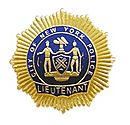 |
|||
| Sergeant | (sleeve) | 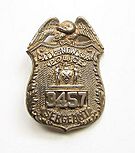 |
Yes | Navy blue shirt, peaked cap, gold hat badge |
|
| Detectives | None | 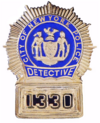 |
|||
| Police Officer | 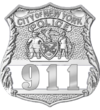 |
Silver | Yes, matching hat badge |
Navy blue shirt, peaked cap, silver hat badge with matching number |
|
| Probationary Police Officer | |||||
| Recruit Officer | Yes | Slate grey, black garrison cap |
|||
| Cadet | None | ||||
^ †: Rank that has no police powers
Who Works for the NYPD?
As of October 2023, the NYPD has 33,536 uniformed officers. It also has 19,454 civilian employees. This includes about 4,500 auxiliary police officers, 5,500 school safety agents, and 3,500 traffic enforcement agents. The Police Benevolent Association of the City of New York (NYC PBA) is the largest police union in the U.S. It represents over 50,000 active and retired NYPD officers.
In 2023, about 53% of the NYPD's police force were from minority groups.
Women in the NYPD
On January 1, 2022, Keechant Sewell became the first woman to be the Commissioner of the NYPD. Juanita N. Holmes was the first Black woman to lead the Patrol Bureau in 2020. She was the highest-ranked uniformed woman in the NYPD at that time.
Where Officers Live
NYPD officers can live in New York City or in nearby counties like Westchester and Nassau. About half of them live outside the city. There have been talks about requiring new officers to live in New York City.
Officers Who Died in the Line of Duty
Since 1849, the NYPD has lost 932 officers while they were on duty. This includes officers from other agencies that later joined the NYPD. Sadly, 23 officers died in the September 11, 2001 attacks. Another 247 officers later died from illnesses related to 9/11. The NYPD has had more officers die in the line of duty than any other police agency in America.
NYPD Services
The NYPD offers many special services. These include the Emergency Service Unit, K9 (police dogs), harbor patrol (boats), and air support (helicopters). They also have teams for bomb threats, counter-terrorism, and investigating organized crime. The NYPD has officers stationed in eleven cities around the world to help with intelligence.
In 2019, the NYPD responded to over 482,000 crime reports. They made over 214,000 arrests. The number of major felonies reported in 2019 was much lower than in the 1980s and 1990s.
Technology Used by NYPD
In the 1990s, the NYPD created the CompStat system. This system helps manage crime data and is now used in many other cities. The NYPD also has advanced crime scene investigation and lab resources. They have units that help with computer crime investigations.
In 2005, the NYPD started a "Real Time Crime Center." This is a huge database that pulls information from police records. It can help identify people based on tattoos, body marks, or even teeth.
The NYPD also uses the Domain Awareness System. This system gathers information from many sources. It includes a network of 9,000 surveillance cameras and license plate readers. This system helps the NYPD track targets and get detailed information. It has access to billions of license plate readings and millions of calls and reports.
In 2020, the NYPD started using a robotic dog called Digidog. It was made by Boston Dynamics. This robot has cameras that send live video. It can move on its own using artificial intelligence. Some people were worried about privacy when Digidog was used. In April 2023, Mayor Eric Adams announced that the Digidog program would be brought back.
Firearms Used by NYPD
On Duty Weapons
New NYPD officers can choose between two types of 9mm service pistols: the Glock 17 Gen4 and Glock 19 Gen4.
Officers who are trained to use shotguns can carry Mossberg 590 shotguns. Special units like the Emergency Service Unit and Counter-terrorism Bureau use other weapons. These include the Colt M4A1 carbine and the Heckler & Koch MP5 submachine gun.
Older Weapons No Longer Used
From 1926 to 1986, the standard weapons were the Smith & Wesson Model 10 and the Colt Official Police .38 Special revolvers. Before 1994, the Smith & Wesson Model 64 and Ruger Police Service Six revolvers were standard. After 1994, the department switched to semi-automatic pistols.
Before semi-automatic pistols, detectives often carried smaller revolvers. These included the Colt Detective Special and the Smith & Wesson Model 36 "Chief's Special." These were easier to hide when officers wore plain clothes.
NYPD Connections
The NYPD works with the New York City Police Foundation and the New York City Police Museum. It also has a Youth Police Academy. This program helps young people learn about police work. The NYPD also sponsors a Law Enforcement Explorer Program through the Scouting Program. They also run a Citizens Police Academy to teach the public about basic laws and policing.
See also
 In Spanish: Departamento de Policía de Nueva York para niños
In Spanish: Departamento de Policía de Nueva York para niños
- Detectives' Endowment Association
- Law enforcement in New York City
- New York City Office of Administrative Trials and Hearings
- Police Benevolent Association of the City of New York
- Police surveillance in New York City
- Sergeants Benevolent Association


